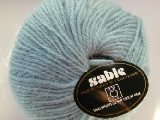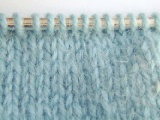

Yarn Profile: Tahki Sable First Impressions
As I unwound the skein, angora fiber strands flew everywhere. It's almost as if the fiber were only rolled onto the edges of the yarn to achieve a fluffy effect. That's fine until you begin working with it and have to stop repeatedly to wipe the fuzz off your nose. Overall the yarn has a soft, almost chalky appearance. Colors are genteel and muted pink, turquoise, and green. Knitting Up
The merino gives it a solid body that is easy to manipulate. Stitches showed beautifully, taking on an almost sculptural look. There was no snagging or unraveling, and I was soon able to knit by touch alone, not needing to watch what I was doing. Blocking / Washing
The stitches flattened perfectly, resulting in a lighter, thinner-seeming fabric with a lovely surface of angora fuzz. After washing, you'd never know there was only 30% angora in this yarn. The gauge expanded ever so slightly from 5 sts/inch to 4 3/4 sts/inch on 4.5mm needles. Keep this expansion in mind when making any pattern measurement calculations. Wearing
Excessive rubbing only matted down the surface slightly and perfumed the air with yet more stray angora fiber. I wasn't able to produce any pilling. Conclusion
If you don't mind the prospect of fuzz, by all means try this yarn. You get a lot of yarn in each skein, and the price is very reasonable. My advice for people who use this yarn: don't wear black, and be sure to cover any nearby beverages while you knit. Otherwise, you'll be covered with angora, both inside and out. Reader Comments
...While I appreciate the wabi-sabi quality of non-commercial yarns - where irregularity is a feature and adds to the appeal - I'd rather have consistency here. Since this is my first time working with Sable, I wonder if I got a wierd batch... ...Apart from this, Sable is a lovely yarn, wonderful to the touch, and I'm not ruling out buying it again." f, 4/04/01 "I read your review of Sable. Have you tried the Jolie which has a larger content of angora? I liked the Sable as well. Some colors seem fluffier than others." knitwit, 1/19/01 Editor's Note: Yes, Jolie is an excellent yarn as well. I found it very similar to Adrienne Vittadini Angelina, except that Angelina has 50% angora, 30% wool, and 20% alpaca, while Jolie is 70% angora and 30% wool. ForKnitters has both yarns if you're interested in comparing colors and prices. |
Yarn name
Sable
Manufacturer
Tahki
Fiber content
70% merino wool 30% French angora
Gauge
24 sts over 4 inch square using US #8 (4.5mm) needles
Average retail
price
$7.95 skein
Where to Buy Online
Since this review was published in 2001, Tahki has discontinued Sable. We are sad to see it go.
Weight/Yardage per Skein
50g / 140 yards
Country of Origin
France
Manufacturer's
suggested wash method
Hand wash and rinse in lukewarm water, lay flat to dry. Low iron, dry cleaning OK.
Review date
01/14/2001 |
Copyright © 2000-2016 Clara H. Parkes
All rights reserved. Permission to reproduce is required.
All rights reserved. Permission to reproduce is required.
